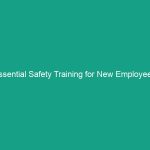Good Morning Team!
Today, we’re going to talk about a crucial aspect of our Workplace Safety: confined space ventilation. This topic is vital for all of us who may work in or around confined spaces, where proper air quality and ventilation are essential for our Safety and health.
Why is this important? Well, confined spaces can pose serious risks if not properly monitored and managed. Adequate ventilation is key to preventing hazardous situations that could lead to health risks or even fatalities.
Understanding Confined Space Ventilation
Confined space ventilation refers to the process of ensuring the air within a confined space is safe to breathe. This involves the removal of contaminated air and the introduction of fresh air to maintain a safe working Environment.
In our daily operations, this can impact us significantly. Poor ventilation can lead to the accumulation of hazardous gases, insufficient oxygen levels, and an overall unsafe working environment. It’s crucial to understand this to protect ourselves and our coworkers.
One common misconception is that simply opening a door or a hatch provides sufficient ventilation. However, effective ventilation often requires more than just passive airflow; it may require specific equipment and Procedures.
Key Hazards, Risks, and Safety Considerations
Working in confined spaces presents unique challenges. Here are some key Hazards associated with inadequate ventilation:
- Oxygen Deficiency: Normal air contains about 21% oxygen. Levels below 19.5% can be dangerous, leading to unconsciousness or even death.
- Hazardous Gases: Spaces can accumulate toxic gases like carbon monoxide, hydrogen sulfide, or methane, which are dangerous even in small amounts.
- Flammable Atmospheres: In some environments, flammable vapors can accumulate, leading to fire or explosion risks.
Ignoring these hazards can lead to severe consequences. For instance, in a recent incident, a worker suffered from asphyxiation due to oxygen deficiency in a poorly ventilated tank. This reinforces the need for effective ventilation strategies.
Best Practices, Procedures, & Actionable Advice
Here’s how we can ensure adequate ventilation in confined spaces:
1. Assess the Space
Before entering any confined space, conduct a thorough risk assessment. Identify potential hazards and the need for ventilation based on the specific environment.
2. Use Ventilation Equipment
Utilize mechanical ventilation when necessary. This may include:
- Blowers: These help to circulate air in and out of the confined space.
- Fans: Use fans to enhance airflow and reduce the concentration of hazardous gases.
3. Monitor Air Quality
Regularly check the air quality using appropriate monitoring devices. This should include:
- Oxygen meters
- Gas detectors for toxic and flammable gases
4. Establish a Ventilation Plan
Develop a clear ventilation plan that outlines:
- The type of ventilation needed
- The duration of ventilation before entry
- Continuous monitoring during work
5. Training and Awareness
Ensure that all employees are trained in confined space entry procedures and understand the importance of ventilation. Regular safety drills can help reinforce this knowledge.
Case Study: Real-World Incident
In an incident at a manufacturing facility, workers entered a confined space without adequate ventilation, leading to multiple cases of gas exposure. The investigation revealed that the lack of a proper ventilation plan was a significant factor. This emphasizes the importance of following the Best Practices we’ve discussed today.
Regulations, Standards, and Compliance
Compliance with safety Regulations is not just a legal requirement; it’s crucial for our safety. Here are some important Standards to be aware of:
- OSHA Standard 1910.146: This outlines the requirements for confined space entry, including ventilation requirements.
- ISO 45001: This international standard provides a framework for Occupational Health and safety management systems.
Following these guidelines ensures we are protecting ourselves and our coworkers while working in confined spaces.
Employee Engagement & Discussion
Now, I want to hear from you. What safety challenges have you encountered related to confined space ventilation? Have there been instances where you felt ventilation was inadequate? Sharing your experiences can help us all stay safe.
Conclusion & Key Takeaways
To wrap up, adequate ventilation in confined spaces is essential for ensuring our safety. Remember:
- Always assess the space before entry.
- Utilize the right ventilation equipment.
- Monitor air quality consistently.
- Develop and follow a clear ventilation plan.
- Stay informed and trained on safety protocols.
Let’s commit to prioritizing safety and ensuring we all go home healthy at the end of the day. Thank you for your attention and dedication to Workplace Safety!


